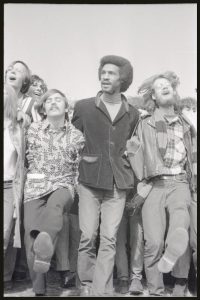A solar eclipse occurs when the moon passes between earth and the sun and thereby totally or partly blocks the sun for a viewer on earth. A total solar eclipse occurs in a narrow path across earth’s surface, with a partial solar eclipse visible in the surrounding region.
The total solar eclipse of March 7, 1970 was visible across southern Mexico and the southeast coast of the United States and Canada. The lengthiest eclipse occurred over Mexico, with totality lasting 3 minutes and 28 seconds. The longest duration in the United States was 3 minutes and 10 seconds. This eclipse, also known as the “eclipse of the century,” passed directly over NASA’s Wallops Station, where researchers launched 32 sounding rockets to conduct meteorological and physics experiments.
A group called the Aquarians organized a celebration of the 1970 eclipse near the Washington Monument and Sylvan Theater on the National Mall. Patrick Frazier photographed the concert and the participants.

Participants singing and dancing at Aquarians’ Sun-In Event on the National Mall in Washington, D.C.
On Aug. 21, 2017, the path of the total eclipse will stretch from Lincoln Beach, Oregon to Charleston, South Carolina and will be about 70 miles wide. The longest duration of total eclipse will be near Carbondale, Illinois, where the moon will completely cover the sun for 2 minutes and 40 seconds.
The last time the contiguous U.S. saw a total eclipse was in 1979. You can watch NASA’s live video stream.
